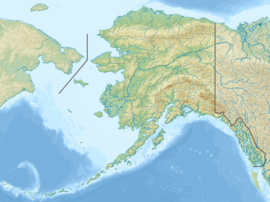Earth:The Rowel
| The Rowel | |
|---|---|
 East aspect | |
| Highest point | |
| Elevation | 9,806 ft (2,989 m) [1][2] |
| Prominence | 1,056 ft (322 m) [3] |
| Parent peak | Mount Spurr[3] |
| Isolation | 2.13 mi (3.43 km) [3] |
| Coordinates | [ ⚑ ] : 61°18′49″N 152°11′41″W / 61.3136111°N 152.1947222°W [4] |
| Naming | |
| Etymology | Rowel |
| Geography | |
| Country | United States |
| State | Alaska |
| Borough | Kenai Peninsula |
| Parent range | Alaska Range Tordrillo Mountains[5] |
| Topo map | USGS Tyonek B-6 |
| Climbing | |
| Easiest route | Expedition climbing |
The Rowel is a 9,806-foot-elevation (2,989-meter) mountain summit in Alaska.
Description
The Rowel is located 77 miles (124 km) west of Anchorage in the Tordrillo Mountains which are a subrange of the Alaska Range. The remote glaciated peak ranks as the 10th-highest peak in the Tordrillo Mountains,[5] and 598th-highest summit in Alaska.[3] It is set 2.1 mi (3 km) northeast of Mount Spurr which is the nearest higher summit.[5] Precipitation runoff from the peak's north slope drains to the Chichantna River, whereas the south and east slopes drain to the Chakachatna River. Topographic relief is significant as the east face rises over 4,800 feet (1,463 meters) in one mile (1.6 km). The mountain's descriptive name "rowel" refers to the sharp-toothed wheel on the end of a spur and the toponym was officially adopted in 1999 by the United States Board on Geographic Names.[4] The name is a pun as this sharp peak is situated around the perimeter of Mt. Spurr.[2]
Climate
Based on the Köppen climate classification, The Rowel is located in a tundra climate zone with long, cold, snowy winters, and cool summers.[6] Weather systems are forced upwards by the Alaska Range (orographic lift), causing heavy precipitation in the form of snowfall. Winter temperatures can drop below −10 °F with wind chill factors below −20 °F. This climate supports glaciers surrounding the peak including the Capps Glacier to the northeast. The months May through June offer the most favorable weather for viewing or climbing.[7]
See also
- Mountain peaks of Alaska
- Geography of Alaska
References
- ↑ United States Board on Geographic Names, Decisions on Geographic Names in the United States, Decision List 1999, (1999), page 2.
- ↑ 2.0 2.1 Stephen Josiah Spurr, In Search of the Kuskokwim and Other Great Endeavors: The Life and Times of J. Edward Spurr, Epicenter Press, 2010.
- ↑ 3.0 3.1 3.2 3.3 "Rowel, The - 9,806' AK". https://listsofjohn.com/peak/142897. Retrieved 2024-01-11.
- ↑ 4.0 4.1 "The Rowel". United States Geological Survey. https://geonames.usgs.gov/apex/f?p=gnispq:3:::NO::P3_FID:1841447.
- ↑ 5.0 5.1 5.2 "The Rowel, Alaska". http://www.peakbagger.com/peak.aspx?pid=26299.
- ↑ Peel, M. C.; Finlayson, B. L.; McMahon, T. A. (2007). "Updated world map of the Köppen−Geiger climate classification". Hydrol. Earth Syst. Sci. 11 (5): 1633. doi:10.5194/hess-11-1633-2007. ISSN 1027-5606. Bibcode: 2007HESS...11.1633P.
- ↑ Denali FAQ, American Alpine Institute, alpineinstitute.com, Retrieved 2024-01-08.
External links
- Weather forecast: The Rowel
Template:Geographic Location 2
 |



